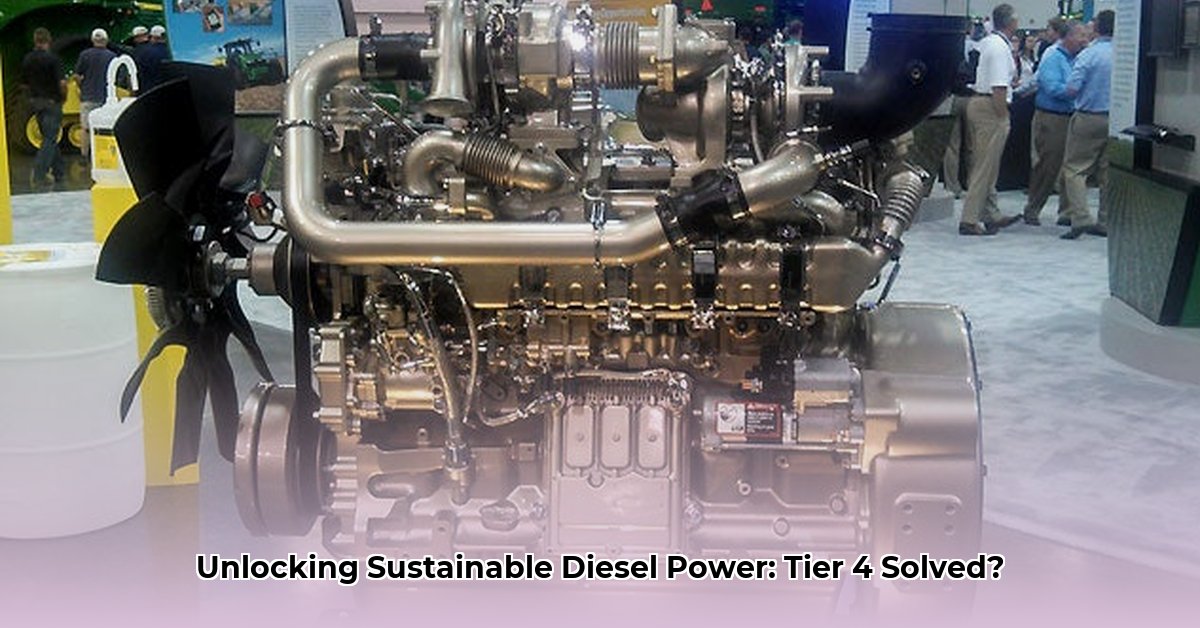
Diesel Tractor Engine Technology: A Journey to Tier 4 Final
Farming's environmental footprint is under increasing scrutiny, pushing a significant shift towards cleaner diesel tractor engines. Tier 4 Final (FT4) emission standards represent a major leap in this direction, mandating significant reductions in harmful pollutants like nitrogen oxides (NOx) and particulate matter (PM). But this leap forward presents both opportunities and challenges for farmers. This article explores the technology behind FT4 compliance, its benefits and drawbacks, and offers practical guidance for efficient maintenance and management. For more information on John Deere's approach to FT4, visit their website here.
Understanding the Evolution of Diesel Engine Technology and FT4 Compliance
For decades, diesel engines powered agriculture, but their emissions posed environmental concerns. FT4 addresses this by integrating advanced emission control technologies. Two primary technologies stand out:
- Selective Catalytic Reduction (SCR): (A system that uses a special fluid, diesel exhaust fluid or DEF, to convert harmful NOx into harmless nitrogen and water.) Think of it as a chemical filter cleaning up the exhaust.
- Exhaust Gas Recirculation (EGR): (A system that routes a portion of exhaust gases back into the engine's combustion chamber, lowering combustion temperatures and reducing NOx formation.) This reduces NOx by lowering combustion temperatures.
These technologies, while significantly reducing emissions, increase engine complexity and maintenance requirements compared to older models. This complexity represents a key trade-off—cleaner emissions come at the price of increased sophistication.
FT4 Compliance: Weighing the Benefits and Challenges
The transition to FT4-compliant engines offers several advantages:
- Environmental Benefits: Dramatically reduced NOx and PM emissions contribute to cleaner air and a healthier environment. This is undeniably a major positive for all.
- Potential Fuel Efficiency: While initial costs are higher, improved engine efficiency in many cases translates to long-term fuel savings. This depends significantly on usage patterns and engine type.
- Reduced Noise: FT4 engines often operate more quietly than their predecessors, improving working conditions for farmers.
However, challenges also exist:
- Higher Initial Costs: The advanced technologies incorporated into FT4 engines lead to a significant increase in upfront purchasing costs.
- Increased Maintenance Complexity: Routine maintenance is more involved, incorporating DEF fluid management and specialized servicing for components like the Diesel Particulate Filter (DPF).
- ULSD Fuel Dependency: Ultra-Low Sulfur Diesel (ULSD) fuel is required, and its availability might be a concern depending on location and infrastructure.
Maintaining Your FT4 Engine: A Practical Guide
Effective maintenance is critical for optimal performance and longevity of FT4 engines. Key tasks include:
- DPF Regeneration: This process, either automatic or active, burns off accumulated soot in the DPF. Ignoring warning signs can lead to costly blockages. Regular monitoring is crucial.
- DEF Fluid Management: Maintaining sufficient DEF fluid levels is essential for SCR system function. Running low can severely impact performance and necessitate costly repairs.
- Scheduled Servicing: Adhering to the manufacturer's recommended service intervals is paramount for preventing premature wear and tear. Proactive maintenance is significantly cheaper than emergency repairs.
- Understanding Warning Lights and Codes: Familiarizing yourself with your engine's warning system allows for prompt identification and addressing of potential issues before they escalate into major problems.
Stakeholder Roles in the Transition to FT4
The transition to FT4 is a collaborative effort involving multiple stakeholders:
| Stakeholder | Role |
|---|---|
| Farmers/Operators | Implementing proper maintenance and understanding engine technology. |
| Equipment Manufacturers | Designing cost-effective and reliable FT4 systems. |
| Government/Regulatory Agencies | Setting and enforcing standards, supporting research and education. |
| Fuel Suppliers | Ensuring widespread availability of high-quality ULSD fuel. |
Each stakeholder has a critical role in ensuring the successful and sustainable adoption of FT4 technology.
Regulatory Landscape and Future Outlook
The Environmental Protection Agency (EPA) plays a central role in shaping emission standards. Future regulations likely will be even stricter, demanding further innovations in engine technology and fuels. This necessitates continued research, collaboration, and a proactive approach by all involved to maintain economic viability while upholding environmental responsibility. The focus should be on balancing stricter emissions with the economic realities faced by farmers.
Conclusion: A Sustainable Path Forward
The transition to FT4-compliant diesel tractor engines is a critical step toward more sustainable agriculture. While higher initial investment and maintenance costs represent challenges, the environmental and potential long-term economic benefits provide a compelling case for adoption. Through responsible maintenance, proactive collaboration among stakeholders, and ongoing technological development, the agricultural industry can navigate this transition effectively while preserving both environmental and economic sustainability. This requires a strategic approach that prioritizes both immediate and long-term success.